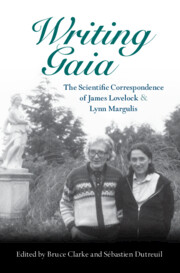Book contents
- Writing Gaia: The Scientific Correspondence of James Lovelock and Lynn Margulis
- Reviews
- Writing Gaia: The Scientific Correspondence of James Lovelock and Lynn Margulis
- Copyright page
- Epigraph
- Table of Contents
- Figures
- Contributors
- Foreword by James Lovelock
- Preface
- Acknowledgements
- Introduction
- Part I 1970–1972
- Part II 1973–1979
- Part III 1980–1991
- Part IV 1992–2007
- Part V Commentaries on Lovelock and Margulis
- Darwinizing Gaia
- Gaia at the Margulis Lab
- Gaia and the Water of Life
- Gaia as a Problem of Social Theory
- Befriending Gaia: My Early Correspondence with Jim Lovelock
- Gaia’s Pervasive Influence
- Gaia’s Microbiome
- Tangled Up in Gaia
- Lovelock and Margulis
- Discovering Geology, Discovering Gaia
- Glossary of Names
- Glossary of Terms
- Bibliography
- Index
Darwinizing Gaia
from Part V - Commentaries on Lovelock and Margulis
Published online by Cambridge University Press: 28 July 2022
- Writing Gaia: The Scientific Correspondence of James Lovelock and Lynn Margulis
- Reviews
- Writing Gaia: The Scientific Correspondence of James Lovelock and Lynn Margulis
- Copyright page
- Epigraph
- Table of Contents
- Figures
- Contributors
- Foreword by James Lovelock
- Preface
- Acknowledgements
- Introduction
- Part I 1970–1972
- Part II 1973–1979
- Part III 1980–1991
- Part IV 1992–2007
- Part V Commentaries on Lovelock and Margulis
- Darwinizing Gaia
- Gaia at the Margulis Lab
- Gaia and the Water of Life
- Gaia as a Problem of Social Theory
- Befriending Gaia: My Early Correspondence with Jim Lovelock
- Gaia’s Pervasive Influence
- Gaia’s Microbiome
- Tangled Up in Gaia
- Lovelock and Margulis
- Discovering Geology, Discovering Gaia
- Glossary of Names
- Glossary of Terms
- Bibliography
- Index
Summary
Lynn Margulis was the leading proponent of the endosymbiont hypothesis for the origin of the organelles of eukaryotes. We were involved in proving this hypothesis in 1975, using the oligonucleotide cataloguing methods developed by Carl Woese, whose three-domain phylogeny Lynn would resist in favor of her five-kingdom model. Lynn and I became close friends during my sabbatical in Boston in 1977–78, so I was primed to read Jim Lovelock’s first book on Gaia when it came out in 1979 (Lovelock 1979a). It both delighted and infuriated me. I thought the book charming in its description of Life on our planet but deeply wrongheaded about evolution by natural selection. It more-or-less clearly invoked natural selection as the cause of Gaia’s supposed homeostasis-like feedback properties, and seemingly necessary for the maintenance of Life on this planet over the last 4 billion years. So incensed (and ambitious) was I then that I wrote up a little review of the book for the New York Review of Books. Of course they summarily rejected it – I’m not in their stable – and after some soul-searching, and with Lynn’s help, the essay was published in Stewart Brand’s CoEvolution Quarterly, the successor to The Whole Earth Catalog (Doolittle 1981a). Lynn was then happy to disagree, and her counter-essay, along with Jim’s, appeared after mine.
- Type
- Chapter
- Information
- Publisher: Cambridge University PressPrint publication year: 2022

